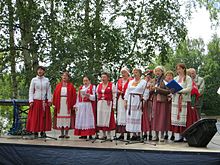Izhorians
 Flag of Izhorians | |
 Izhorian choir wearing the national costume | |
| Total population | |
|---|---|
| approx. 1.000 | |
| Regions with significant populations | |
| 812(2001)[1] | |
| 781(2021)[2] | |
| 56(2011)[3] | |
| 8(1999)[4] | |
| 1(2018)[5] | |
| Languages | |
| Izhorian,Russian,Estonian | |
| Religion | |
| Eastern Orthodox Christianity Lutheranminority | |
| Related ethnic groups | |
| OtherBaltic Finns EspeciallyVotians,KareliansandFinns(particularlyIngrian FinnsandKorlaks) | |
TheIzhorians(Ingrian:ižorat, ižorit, inkeroiset;‹See Tfd›Russian:ижо́ра; ижо́ры, ижо́рцы;Finnish:inkerikot;Estonian:isurid) are aFinnicindigenous people native toIngria.Small numbers can still be found in the western part of Ingria, between theNarvaandNevarivers in northwestern Russia. Although in English oftentimes sharing a common name with theIngrian Finns,these two groups are distinct from one another.
History
[edit]

The history of the Izhorians is bound to the history of Ingria. It is supposed that shortly after 1000 AD the Izhorians moved fromKareliato the west and south-west. In 1478, theNovgorod Republic,where Ingrians had settled, was united with theGrand Duchy of Moscow,and some of the Izhorians were transferred to the east. The establishment ofSt Petersburgin 1703 had a great influence on Izhorian culture.World War IIhad the biggest impact on Izhorians, as devastating battles (such as theSiege of Leningrad) took place on their territory.

In 1848, P. von Köppen counted 17,800 Izhorians, and by 1926 there were 26,137 Izhorians in theRussian SFSR.In the 1959 census, however, only 1,100 Izhorians were counted in theUSSR.In 1989, 820 self-designated Izhorians, 302 of whom were speakers of theIngrian languagewere registered. 449 Izhorians lived in the territory of theUSSR.According to the2002 Russian Census,there were 327 Izhorians in Russia, of whom 177 lived inLeningrad oblastand 53 in St Petersburg. There were also 812 Izhorians inUkraineaccording toUkrainian Census (2001)(more than inRussian FederationandEstoniaaltogether) and a further 358 Izhorians inEstonia.
Language
[edit]
Their language, close toKarelian,is used primarily by members of the older generation. Izhorian (also called Ingrian), along withFinnish,Ludic,Karelian andVepsian,belongs to the NorthernFinnicgroup of theUralic languages.
In 1932–1937, a Latin-based orthography for the Izhorian language existed, taught in schools of theSoikinsky Peninsulaand the area around the mouth of theLuga River.[6]Several textbooks were published including a grammar of the language in 1936. However, in 1937 the Izhorian written language was abolished.[6]
Religion
[edit]The Izhorians and theVotesare generallyEastern Orthodox,while the otherBaltic Finnsinhabitanting Ingria, theIngrian Finns,are generallyLutheran.Some pre-Christian traditions exist also.
References
[edit]- ^"Ukrainian Census of 2001".[permanent dead link]
- ^"Оценка численности постоянного населения по субъектам Российской Федерации".Federal State Statistics Service.Retrieved31 August2024.
- ^"RL0428: Rahvastik rahvuse, soo ja elukoha järgi, 31. detsember 2011".
- ^"Nationalities of Belarus".Archived fromthe originalon 2009-08-15.
- ^"Population distribution of Latvia by ethnic composition and citizenship as of 01.07.2018. - Office of Citizenship and Migration Affairs"(PDF).Archived fromthe original(PDF)on 2018-11-15.Retrieved2018-11-15.
- ^abKurs, Ott (1994). "Ingria: The broken landbridge between Estonia and Finland".GeoJournal.33(1): 107–113.doi:10.1007/BF00810142.S2CID153619971.
External links
[edit]- Izhoriansin theRed Book of the Peoples of the Russian Empire
- Estonian National Museum(in Estonian)

